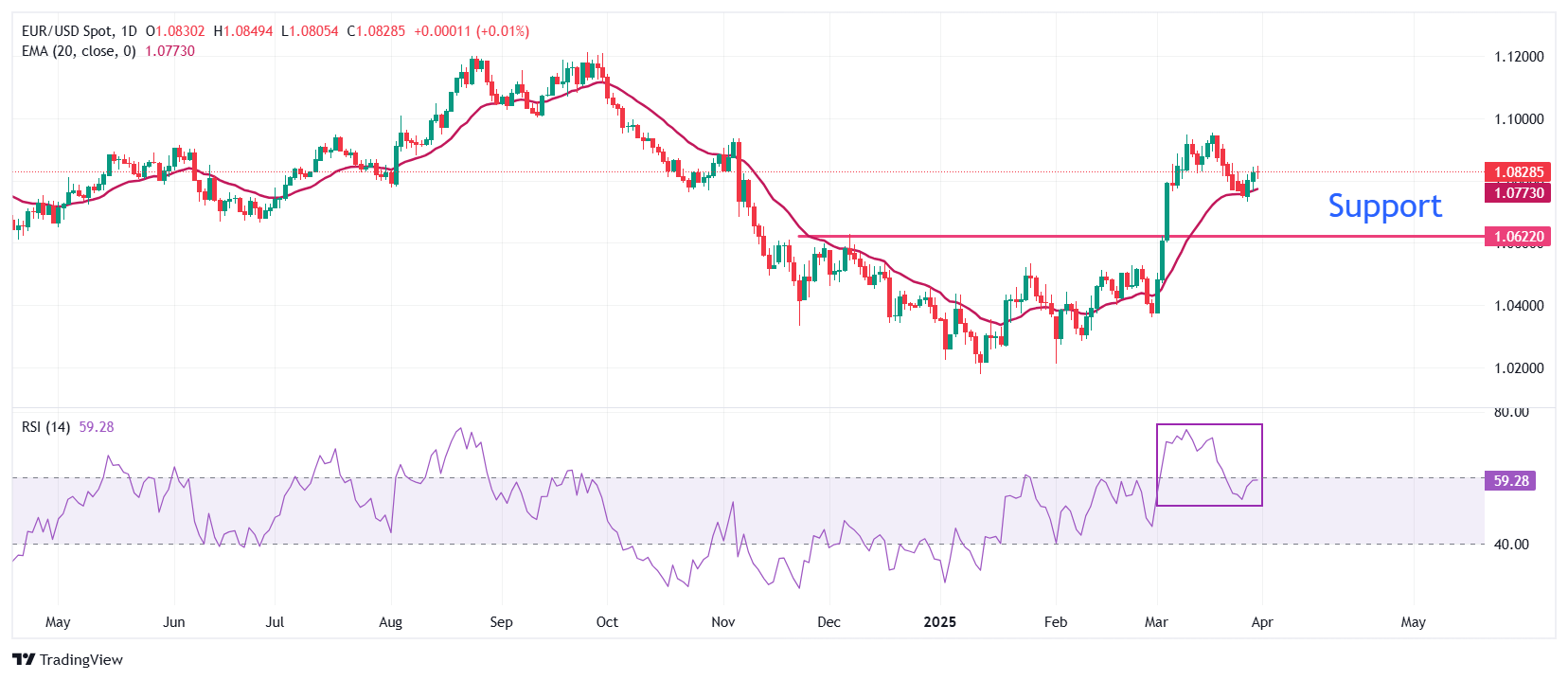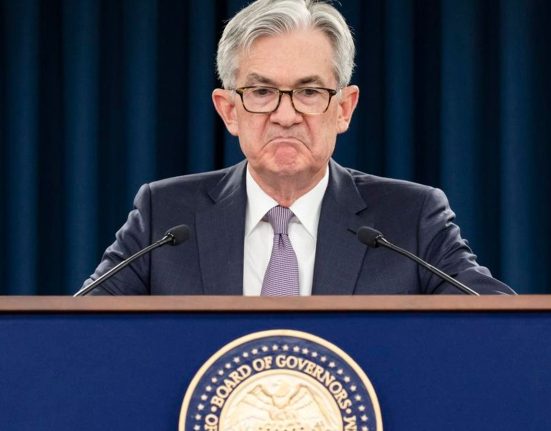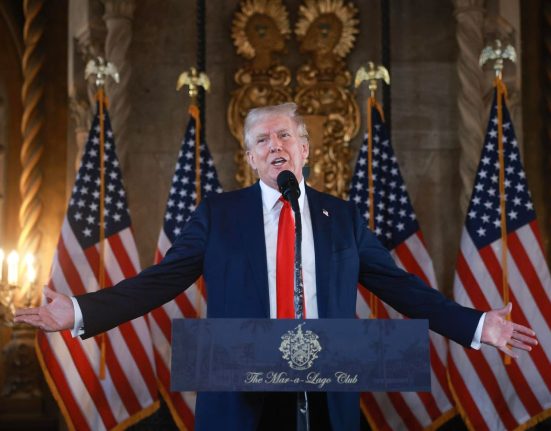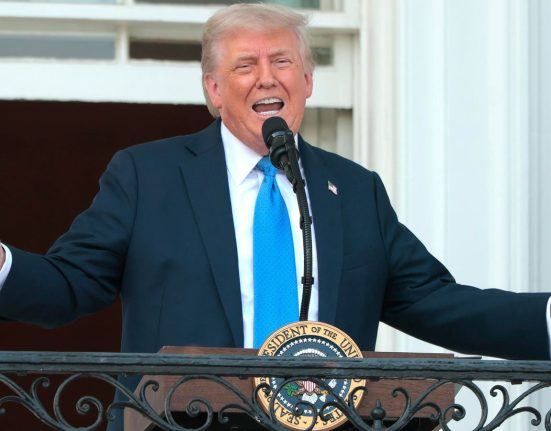- EUR/USD wobbles around 1.0830 as investors have been sidelined, focusing on Trump’s reciprocal tariff measures to be released on Wednesday.
- This week, the US Dollar will also be influenced by the US ISM PMI and a slew of employment-related data, ending with the NFP for March on Friday.
- The EU Commission agrees to provide a ‘term sheet’ of concessions for the US.
EUR/USD trades sideways around 1.0830 in Monday’s European session as investors await the announcement of planned reciprocal tariffs by United States (US) President Donald Trump on Wednesday. Investors expect President Trump to impose significant tariffs on the Eurozone as he has criticized the European Union (EU) for not buying American goods.
In 2024, Ireland and Germany were the fourth and fifth, respectively, largest nations having trade surplus with the US, according to the World Population Review. Trump’s higher import duties on the Eurozone would significantly impact its economic growth. During European trading hours, European Central Bank (ECB) President Christine Lagarde stated that any ensuing trade war would be a lose-lose scenario and lower Eurozone growth by at least 0.3%.
Last week, Trump also imposed 25% tariffs on imports of foreign cars and light trucks, which will come into effect on Wednesday. In response, the EU Commission warned of retaliatory measures but later agreed to provide concessions to the US to secure the partial removal of tariffs that have already hit and are expected to increase further on April 2, Bloomberg reported.
On the monetary policy front, ECB policymaker and Governor of Bank of Italy said in a speech in Rome during European trading hours that the “fight against inflation cannot be considered over” due to increased uncertainty, especially “contradictory US policy announcements“, which calls for “caution on further interest rate cuts”.
In Monday’s session, the Euro (EUR) will be influenced by preliminary German Harmonized Index of Consumer Prices (HICP) data for March, which will be published at 12:00 GMT. German HICP is estimated to rise by 2.4% year-over-year compared to the 2.6% increase seen in February. Meanwhile, six states of Germany have indicated mixed flash Consumer Price Index (CPI) data for March. Year-on-year inflation in Germany states: Saxony and Hesse accelerated, but it slowed in Baden-Wuettemberg and Bavaria. Price pressures grew steadily in Brandenburg and North Rhine-Westphalia.
On Friday, France and Spain’s March preliminary inflation data showed that price pressures rose at a slower-than-expected pace. The impact of German inflation is expected to be limited on market expectations for the ECB’s monetary policy outlook as investors anticipate a resurgence in inflation and a slowdown in economic growth in the Eurozone due to Donald Trump’s tariff agenda.
Daily digest market movers: EUR/USD steadies while US Dollar trades cautiously
- The sideways movement in the EUR/USD pair is also driven by a cautious trend in the US Dollar (USD) ahead of Trump’s reciprocal tariff announcemnet on Liberation Day. The US Dollar Index (DXY), which tracks the Greenback’s value against six major currencies, posts a fresh 10-day low around 103.75.
- Financial market participants expect that Trump’s reciprocal tariffs will be unfavorable for economic growth and will reignite inflation across the globe, including the US. According to the Washington Post, the President keeps telling his advisers to increase trade measures, and in recent days, he has brought back the idea of a universal tariff that would be applicable to most imports, no matter which country they come from.
- The Washington Post also showed that US President Trump expressed regret for not imposing broader tariffs in his first term and was confident that levies would be a win for the US. Higher import duties will bring back manufacturing jobs and add trillions in government revenue.
- This week, investors will also focus on a slew of US economic data, such as the ISM Manufacturing and Services Purchasing Managers Index (PMI) and labor market-related indicators, which will influence market speculation for the Federal Reserve’s (Fed) monetary policy outlook.
- According to the CME FedWatch tool, the Fed is expected to keep interest rates at their current levels in the May policy meeting. However, the probability for an interest rate cut in June has increased to 83.5% from 65.6% recorded a week ago.
Technical Analysis: EUR/USD holds key 20-day EMA
EUR/USD trades indecisively around 1.0830 at the start of the week. The near-term outlook of the pair remains firm as it holds the 20-day Exponential Moving Average (EMA), which trades around 1.0773.
The 14-day Relative Strength Index (RSI) cools down below 60.00, suggesting that the bullish momentum is over, but the upside bias is intact.
Looking down, the December 6 high of 1.0630 will act as the major support zone for the pair. Conversely, the psychological level of 1.1000 will be the key barrier for the Euro bulls.
BRANDED CONTENT
Finding the right broker for trading EUR/USD is crucial, and we’ve identified the top choices for this major currency pair. Read about their unique features to make an informed decision.







